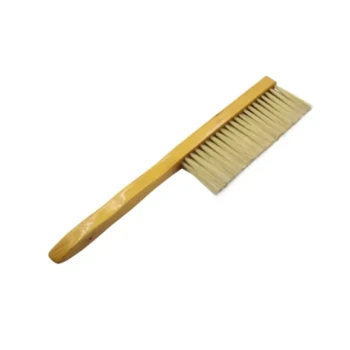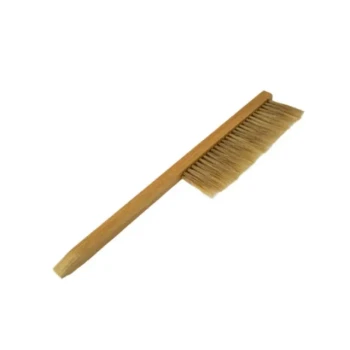When harvesting pollen, the health of your colony is paramount. The recommended duration for keeping a pollen trap on a single hive is for a maximum of two weeks per season. Critically, this should only be done during periods of major pollen availability to ensure you are harvesting a surplus, not the hive's essential resources.
A pollen trap fundamentally alters a colony's ability to gather its essential protein source. Limiting its use to short, strategic periods during peak pollen flow is not just a recommendation—it is a necessary practice to protect the colony's brood production and long-term viability.

Why Limiting Trap Duration is Critical for Hive Health
A pollen trap is an extractive tool. Understanding its full impact on the colony's internal dynamics is key to using it responsibly.
The Central Role of Pollen
Pollen is the honey bee colony's sole source of protein, lipids, vitamins, and minerals. Nurse bees consume it to produce royal jelly, which is fed to the queen and the youngest larvae.
After a few days, older larvae are weaned onto a mixture of pollen and nectar known as "bee bread." Without a consistent and abundant supply of pollen, a colony simply cannot raise the next generation of bees.
The Direct Impact on Brood Rearing
Restricting the flow of incoming pollen sends an immediate signal to the colony to slow down. The queen may reduce her laying rate, and the nurse bees may be forced to ration food for the existing larvae.
Prolonged pollen collection directly translates to a smaller, weaker workforce in the coming weeks. This can severely handicap the colony's ability to collect nectar, defend the hive, and prepare for winter.
Increased Stress on Foragers
A pollen trap works by stripping pollen pellets from the bees' legs as they enter the hive. This means a forager loses a portion of its hard-won payload on every return trip.
To compensate for this loss, bees must conduct more foraging trips to meet the colony's needs, leading to premature aging, exhaustion, and a shorter lifespan. This constant stress wears down the hive's most productive members.
Understanding the Trade-offs of Pollen Collection
Harvesting pollen presents a classic trade-off between the beekeeper's goals and the colony's biological needs.
The Beekeeper's Gain: A Nutrient-Rich Harvest
For the beekeeper, harvested pollen is a valuable, nutrient-dense superfood. It represents a tangible product from the hive beyond just honey.
The Colony's Cost: A Critical Protein Deficit
For the hive, the cost is a "tax" on their primary protein income. You are taking the very resource they need to grow their population and maintain strength.
The Risk of Over-Harvesting
Leaving a trap on for too long moves from harvesting a surplus to creating a deficit. The consequences are severe: a dwindling population, increased susceptibility to pests like Varroa mites and diseases like chalkbrood, and a significantly reduced chance of surviving the winter.
Making the Right Choice for Your Goal
Always assess your primary objective before placing a pollen trap on any hive.
- If your primary focus is maximizing hive health and honey production: Use a pollen trap sparingly, if at all. The negative impact on population growth often outweighs the benefit of the pollen collected.
- If your primary focus is a sustainable pollen harvest: Adhere strictly to the two-week maximum, use it only on your strongest colonies, and deploy it only during a visible, intense pollen flow.
- If your primary focus is hive monitoring: Using a trap for a single day can provide valuable insight into the types of pollen your bees are collecting, which can inform you about local forage availability.
By treating pollen harvesting as a strategic intervention rather than a constant drain, you ensure the long-term prosperity of your hives.
Summary Table:
| Key Consideration | Recommendation |
|---|---|
| Maximum Duration | 2 weeks per season |
| Timing | During periods of major pollen flow |
| Primary Goal | Harvest surplus, not essential resources |
| Impact on Hive | Protects brood rearing and forager health |
Ensure your commercial apiary or distribution business has the right equipment for sustainable beekeeping. HONESTBEE supplies durable, bee-friendly pollen traps and other essential beekeeping supplies to commercial apiaries and distributors through our wholesale-focused operations. Protect your investment and your hives with equipment designed for professional use. Contact our team today to discuss your wholesale needs and optimize your harvest strategy.
Visual Guide

Related Products
- HONESTBEE Advanced Ergonomic Stainless Steel Hive Tool for Beekeeping
- Professional Dual-End Stainless Steel Hive Tool for Beekeeping
- Professional 3-Bar Frame Grip with Integrated Hive Tool
- Wooden Bee Brush with Triple Row Artificial Fiber for Beekeeping
- Full Set Beekeeping Electronic Bee Venom Collector Machine Device for Bee Venom Collecting
People Also Ask
- How should beekeepers handle bees when using a hive tool? Master Calm, Deliberate Techniques
- How is a hive tool used for scraping and cleaning? Master Hive Maintenance for a Healthy Colony
- What are the basic tools for beekeeping? Essential Starter Kit for Safe & Successful Hive Management
- What is a hive tool and what are its uses? Master Your Hive Inspections with the Essential Beekeeper's Tool
- What is the hole in a hive tool for? A Multi-Tool for Apiary Repairs and Maintenance



















